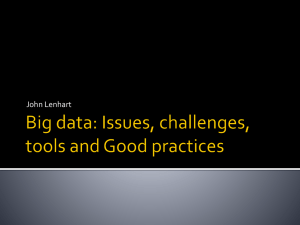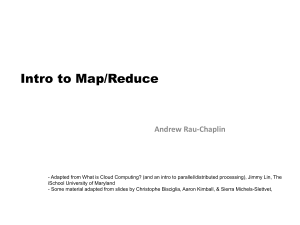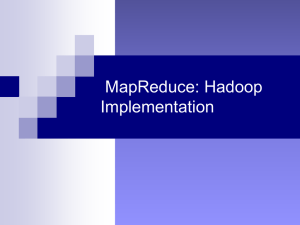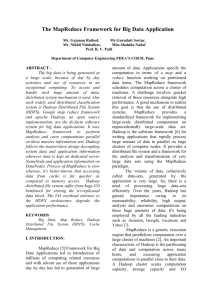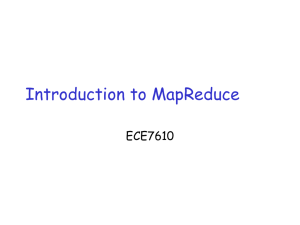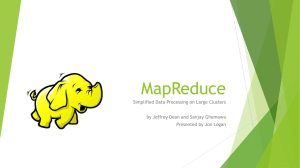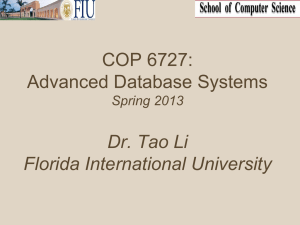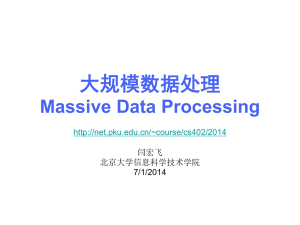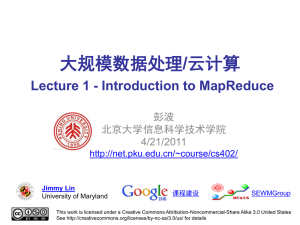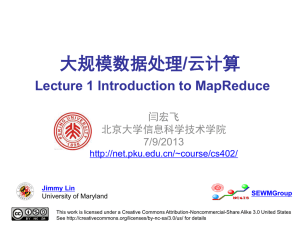The Definitive Cloudera Hadoop WordCount Tutorial
advertisement
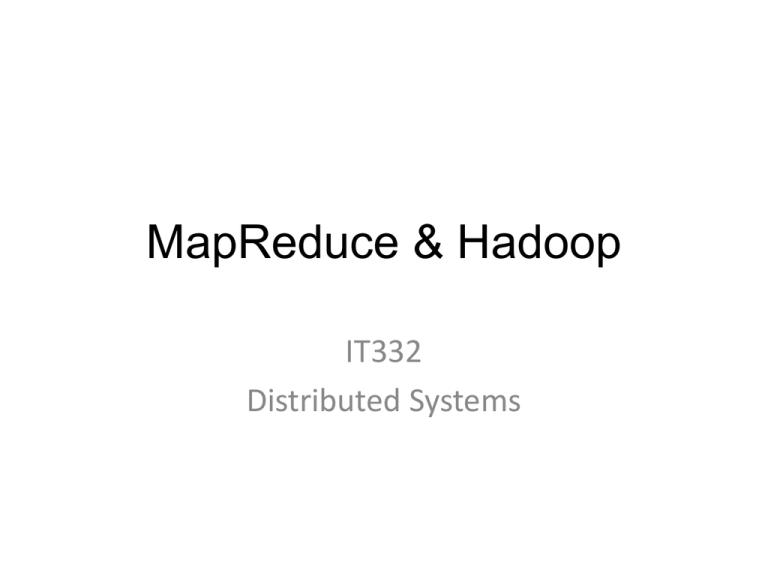
MapReduce & Hadoop IT332 Distributed Systems Outline MapReduce Hadoop Cloudera Hadoop Tutorial 2 MapReduce MapReduce is a programming model for data processing The power of MapReduce lies in its ability to scale to 100s or 1000s of computers, each with several processor cores How large an amount of work? Web-Scale data on the order of 100s of GBs to TBs or PBs It is likely that the input data set will not fit on a single computer’s hard drive Hence, a distributed file system (e.g., Google File System- GFS) is typically required 3 MapReduce Characteristics MapReduce ties smaller and more reasonably priced machines together into a single cost-effective commodity cluster MapReduce divides the workload into multiple independent tasks and schedule them across cluster nodes A work performed by each task is done in isolation from one another 4 Data Distribution In a MapReduce cluster, data is distributed to all the nodes of the cluster as it is being loaded in An underlying distributed file systems (e.g., GFS) splits large data files into chunks which are managed by different nodes in the cluster Input data: A large file Node 1 Node 2 Node 3 Chunk of input data Chunk of input data Chunk of input data Even though the file chunks are distributed across several machines, they form a single namesapce 5 MapReduce: A Bird’s-Eye View in The outputs from the mappers are denoted as intermediate outputs (IOs) and are brought into a second set of tasks called Reducers The process of bringing together IOs into a set of Reducers is known as shuffling process The Reducers produce the final outputs (FOs) Overall, MapReduce breaks the data flow into two phases, map phase and reduce phase C0 C1 C2 C3 mappers M0 M1 M2 M3 IO0 IO1 IO2 IO3 chunks Map Phase processed Reduce Phase In MapReduce, chunks are isolation by tasks called Mappers Shuffling Data Reducers R0 R1 FO0 FO1 Keys and Values The programmer in MapReduce has to specify two functions, the map function and the reduce function that implement the Mapper and the Reducer in a MapReduce program In MapReduce data elements key-value (i.e., (K, V)) pairs are always structured The map and reduce functions receive and emit (K, V) pairs Input Splits (K, V) Pairs Intermediate Outputs Map Function (K’, V’) Pairs Final Outputs Reduce Function (K’’, V’’) Pairs as Hadoop Hadoop is an open source implementation of MapReduce and is currently enjoying wide popularity Hadoop presents MapReduce as an analytics engine and under the hood uses a distributed storage layer referred to as Hadoop Distributed File System (HDFS) HDFS mimics Google File System (GFS) 8 Cloudera Hadoop Cloudera Virtual Manager • Cloudera VM contains a single-node Apache Hadoop cluster along with everything you need to get started with Hadoop. • Requirements: – A 64-bit host OS – A virtualization software: VMware Player, KVM, or VirtualBox. • Virtualization Software will require a laptop that supports virtualization. If you are unsure, one way this can be checked by looking at your BIOS and seeing if Virtualization is Enabled. – A 4 GB of total RAM. • The total system memory required varies depending on the size of your data set and on the other processes that are running. Installation • Step#1: Download & Run Vmware • Step#2: Download Cloudera VM • Step#3: Extract to the Cloudera folder. • Step#4: Open the "cloudera-quickstart-vm4.4.0-1-vmware" Once you got the software installed, fire up the VirtualBox image of Cloudera QuickStart VM and you should see the initial screen similar to below: WordCount Tutorial • This example computes the occurrence frequency of each word in a text file. • Steps: 1. Set up Hadoop environment 2. Upload files into HDFS 3. Executing Java MapReduce functions in Hadoop • Tutorial: http://edataanalyst.com/2013/08/the-definitive-cloudera-hadoopwordcount-tutorial/

